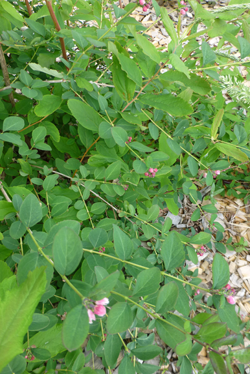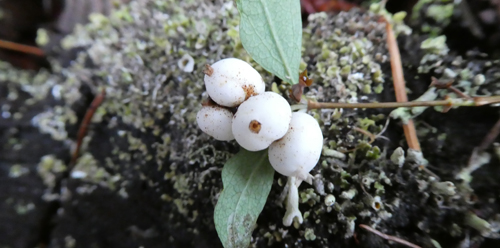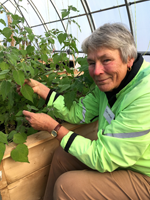Our wildlife depends on Native plants for the food. Whether it is Native bees which depend on Native plants or birds that depend on fruit or seeds, we can lend a helping hand by supplying a food source.
Many of you readers will put out bird seed in the winter to feed the hungry birds, but recently we have heard about a number of infectious diseases killing birds where feeders were not meticulously maintained.
You can lend a hand by growing berries that help some of our birds survive the winter.
Snowberries fall into that category.

A snowberry bush in spring
I am sure you are all familiar with snowberry or wax berry or corpse berry (Latin: Symphoricarpos albus). As kids you likely squished the white berries between your fingers and heard the pleasing “pop”.
In the spring you might have noticed the pink flowers. They are attractive to hummingbirds, especially since they appear in early/mid spring. But their most important wildlife function is to feed birds and larger animals.
In spring, the pink flowers are attractive to hummingbirds. In winter, the berries are “starvation food” for other birds.
When all the good stuff (eg salmonberries, cherries, elderberries, many more delectable seeds from other plants) are eaten, then in late winter/early spring the snow berries are still available and tide the birds over a long, dreary stretch.

Close-up of Snowberry blossom
While not applicable on Vancouver Island, the snowberry bushes are also known as food for Bighorn sheep, grizzly bears and white-tailed deer.
However the berries are considered poisonous to humans, but the juice of the berry found uses as hand lotion in some indigenous cultures and the wood could be used as arrow shafts. And they are pretty in winter bouquets.Many especially those specializing in Native plants, can be sources for getting plants. Snowberries can grow in full sun, but prefer part shade. They tolerate dry, but prefer a bit of soil moisture.
They grow well in open forests, thickets, rocky slopes and even close to beaches. If you have a bank where erosion can be a problem, snowberry may be a good choice. They spread through their rhizomes, but are also spread via birds which have ingested the seeds.
There are two types of snowberries in our area: Symphoricos albus which grows up to 1m (3ft) in height and Symphoricarpos mollis which is much shorter (approx 30 cm or 12 inch). Other than size they are very similar.

Berries of the snowberry bush in fall
A study in Britain by Bristol University and work by the Royal Horticultural Society has found that small urban gardens can be a valuable resource for local pollinators.
They found that if urban gardeners plant strategically they can ensure that there is a continuous supply of open flowers and available nectar. https://www.gardeningetc.com/news/study-importance-of-small-urban-gardens-for-pollinators
Do consider Native plants in your garden to help our Native pollinators and birds!
Gardening Advice:
If you have gardening questions, you can contact the Vancouver Island Master Gardeners at Milner Gardens through email GardeningAdvice.MilnerGardens@shaw.ca . Master Gardeners from the Vancouver Island Master Gardeners Association will research answers to your questions and respond with 3-4 days.
 Dorothee Kieser
Dorothee Kieser
Certified Master Gardener
See all articles by Dorothee Kieser



